#Rhine Province
Photo
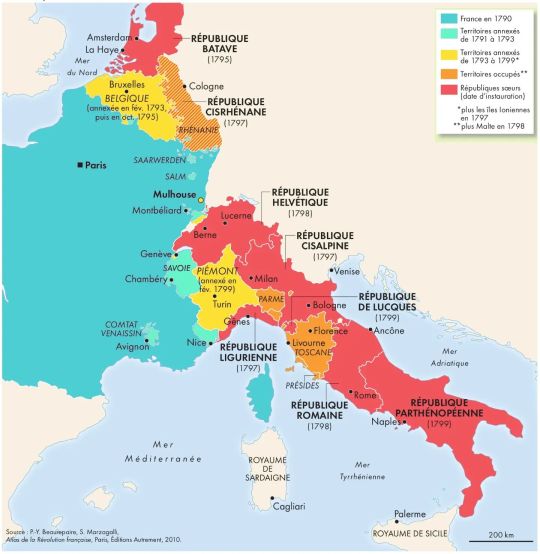
France after the Peace of Lunéville, 1801.
« Nouvel atlas de l’histoire de France », Cohen, Destemberg, Dusserre & Houte, Autrement, 2016
by cartesdhistoire
Belgium was annexed on October 1, 1795, after the United Provinces became a sister republic, theoretically independent (treaty of alliance of May 16).
In Italy, Bonaparte won dazzling victories, and between the spring and summer of 1797, he signed armistices, while Italian patriots took advantage of the offensive to proclaim the republic in Piedmont. The Peace of Campoformio (October 17, 1797) gave Austria the archbishopric of Salzburg and Veneto but confirmed the possession of Belgium and the left bank of the Rhine (from Alsace to Koblenz) to France, finalizing the birth of the Ligurian and Cisalpine Republics. In February 1798, French military intervention allowed Roman patriots to proclaim the Republic. These were allied states – with very formal independence.
In January 1799, the patriots led General Championnet to proclaim the ephemeral Neapolitan Republic which lasted only until June 24. However, after the occupation of Tuscany by French troops, all of Italy except Venice was occupied by the French, and most of it formed republics. The Italian unity desired by the patriots was possible, but the Directory took care, on the contrary, to prevent it definitively: from February 8 to 16, 1799, a referendum took place in Piedmont which gave a strong majority for annexation by France (effective on September 11, 1802).
On February 9, 1801, the Treaty of Lunéville was signed between France and Austria. It confirmed for France the possession of the Austrian Netherlands, the principality of Liège, and the left bank of the Rhine. Austria had to recognize the Batavian Republic and the Helvetic Republic. Additionally, Article 7 of the treaty provided for compensation to the dispossessed German princes, to whom territories would have to be redistributed, thus giving France the position of continental arbiter.
57 notes
·
View notes
Text
[T]he Dutch Republic, like its successor the Kingdom of the Netherlands, [...] throughout the early modern period had an advanced maritime [trading, exports] and (financial) service [banking, insurance] sector. Moreover, Dutch involvement in Atlantic slavery stretched over two and a half centuries. [...] Carefully estimating the scope of all the activities involved in moving, processing and retailing the goods derived from the forced labour performed by the enslaved in the Atlantic world [...] [shows] more clearly in what ways the gains from slavery percolated through the Dutch economy. [...] [This web] connected them [...] to the enslaved in Suriname and other Dutch colonies, as well as in non-Dutch colonies such as Saint Domingue [Haiti], which was one of the main suppliers of slave-produced goods to the Dutch economy until the enslaved revolted in 1791 and brought an end to the trade. [...] A significant part of the eighteenth-century Dutch elite was actively engaged in financing, insuring, organising and enabling the slave system, and drew much wealth from it. [...] [A] staggering 19% (expressed in value) of the Dutch Republic's trade in 1770 consisted of Atlantic slave-produced goods such as sugar, coffee, or indigo [...].
---
One point that deserves considerable emphasis is that [this slave-based Dutch wealth] [...] did not just depend on the increasing output of the Dutch Atlantic slave colonies. By 1770, the Dutch imported over fl.8 million worth of sugar and coffee from French ports. [...] [T]hese [...] routes successfully linked the Dutch trade sector to the massive expansion of slavery in Saint Domingue [the French colony of Haiti], which continued until the early 1790s when the revolution of the enslaved on the French part of that island ended slavery.
Before that time, Dutch sugar mills processed tens of millions of pounds of sugar from the French Caribbean, which were then exported over the Rhine and through the Sound to the German and Eastern European ‘slavery hinterlands’.
---
Coffee and indigo flowed through the Dutch Republic via the same trans-imperial routes, while the Dutch also imported tobacco produced by slaves in the British colonies, [and] gold and tobacco produced [by slaves] in Brazil [...]. The value of all the different components of slave-based trade combined amounted to a sum of fl.57.3 million, more than 23% of all the Dutch trade in 1770. [...] However, trade statistics alone cannot answer the question about the weight of this sector within the economy. [...] 1770 was a peak year for the issuing of new plantation loans [...] [T]he main processing industry that was fully based on slave-produced goods was the Holland-based sugar industry [...]. It has been estimated that in 1770 Amsterdam alone housed 110 refineries, out of a total of 150 refineries in the province of Holland. These processed approximately 50 million pounds of raw sugar per year, employing over 4,000 workers. [...] [I]n the four decades from 1738 to 1779, the slave-based contribution to GDP alone grew by fl.20.5 million, thus contributing almost 40% of all growth generated in the economy of Holland in this period. [...]
---
These [slave-based Dutch commodity] chains ran from [the plantation itself, through maritime trade, through commodity processing sites like sugar refineries, through export of these goods] [...] and from there to European metropoles and hinterlands that in the eighteenth century became mass consumers of slave-produced goods such as sugar and coffee. These chains tied the Dutch economy to slave-based production in Suriname and other Dutch colonies, but also to the plantation complexes of other European powers, most crucially the French in Saint Domingue [Haiti], as the Dutch became major importers and processers of French coffee and sugar that they then redistributed to Northern and Central Europe. [...]
The explosive growth of production on slave plantations in the Dutch Guianas, combined with the international boom in coffee and sugar consumption, ensured that consistently high proportions (19% in 1770) of commodities entering and exiting Dutch harbors were produced on Atlantic slave plantations. [...] The Dutch economy profited from this Atlantic boom both as direct supplier of slave-produced goods [from slave plantations in the Dutch Guianas, from Dutch processing of sugar from slave plantations in French Haiti] and as intermediary [physically exporting sugar and coffee] between the Atlantic slave complexes of other European powers and the Northern and Central European hinterland.
---
Text above by: Pepijn Brandon and Ulbe Bosma. "Slavery and the Dutch economy, 1750-1800". Slavery & Abolition Volume 42, Issue 1. 2021. [Text within brackets added by me for clarity. Bold emphasis and some paragraph breaks/contractions added by me. Presented here for commentary, teaching, criticism purposes.]
#abolition#these authors lead by pointing out there is general lack of discussion on which metrics or data to use to demonstrate#extent of slaverys contribution to dutch metropolitan wealth when compared to extensive research#on how british slavery profits established infrastructure textiles banking and industrialisation at home domestically in england#so that rather than only considering direct blatant dutch slavery in guiana caribbean etc must also look at metropolitan business in europe#in this same issue another similar article looks at specifically dutch exporting of slave based coffee#and the previously unheralded importance of the dutch export businesses to establishing coffee mass consumption in europe#via shipment to germany#which ties the expansion of french haiti slavery to dutch businesses acting as intermediary by popularizing coffee in europe#which invokes the concept mentioned here as slavery hinterlands#and this just atlantic lets not forget dutch wealth from east india company and cinnamon and srilanka etc#and then in following decades the immense dutch wealth and power in java
24 notes
·
View notes
Text
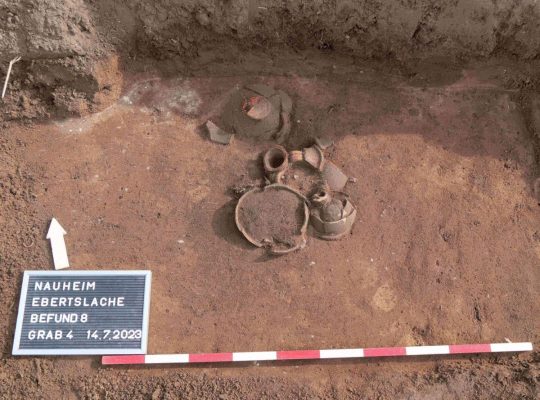
Roman-Era Burials Discovered in Germany
Students from Goethe University Frankfurt, in collaboration with the Hesse archeology department at the Darmstadt branch of the State Monument Protection Agency, uncovered 46 graves from various ethnic groups near Nauheim, a town southwest of Frankfurt in the central-western German state of Hessen.
They uncovered 46 graves from the time when Roman legions were stationed on the Rhine during a six-week training excavation. The grave goods indicate the deceased were immigrants with Gallic funerary customs who settled in the area in the middle of the 1st century A.D.
The team expected to find Roman remains because a Roman military camp was known to have been built in the Nauheim area. The graves of early settlers came as a surprise.
The burial ground, which eight students in two teams brought to light on a good 2,000 square meters, dates from the middle of the 1st century AD to the beginning of the 3rd century. They unearthed a total of 46 graves, 44 of them cremation burials, only two of them inhumations.
Anthropologists will now examine the bone remains from the corpse fire as well as the skeletons and determine the age at death, gender, and diseases.
The Nauheim graves show who settled on the borders of the Hessian Ried almost 2,000 years ago: immigrant ethnic groups in small-scale groups. Grave goods indicate Germanic military farmers who were deliberately attracted by the Romans from the north, took over the security service in the province on the border of the Roman Empire, and then settled down.

In the burial area, a 30-centimeter high vessel, in particular, indicated that the dead of newly arrived settlers found their final resting place here: a bronze bucket that probably served as a burial urn.
An early Nauheimer “in the bucket”. Burying a person in a bronze bucket and providing tools such as scissors or knives is atypical for Roman burials. This is also the first time that evidence of the grave enclosures mentioned has been found in southern Hesse, while the custom was widespread on the left of the Rhine in the east of Gaul in the late Iron Age (1st century BC) and the 1st century AD. For scientists, such unusual burials are clear signs that immigrants were buried here, bringing not only their culture but also their burial rites with them.
The bucket must have been imported here and probably cost a dinar or two,” said Professor Markus Scholz, head of the Archeology and History of the Roman Provinces course at Goethe University. In general, the grave goods – such as a complete urn made of green glass – were of high quality, which indicates a certain level of wealth of those buried.
There are also six rectangular ditch systems that can be viewed as the enclosure of special burials and, according to current knowledge, all belong to the burial ground’s founding phase. In some cases, there are additions such as a complete glass urn, which attest to the wealth of those buried.
By Leman Altuntaş.

#Roman-Era Burials Discovered in Germany#Nauheim Germany#Hessen Germany#ancient graves#ancient tombs#ancient artifacts#archeology#archeolgst#history#history news#ancient history#ancient culture#ancient civilizations#roman history#roman empire
44 notes
·
View notes
Text
LIMAX
I’m tired, I’m bored, let’s talk about the RE18, also sometimes known as LiMAX or Drielandentrein (three countries train).

Euregio
This international regional train connects the region known as Euregio Maas-Rhine, the area around the point where Netherlands, Belgium and Germany meet. The region has a long shared and sometimes weird history. The main cities are Aachen (Germany, about 260,000 inhabitants), Liège (Belgium, about 200,000 people) and Maastricht (Netherlands, about 120,000 folks). A cluster of smaller towns around Heerlen (Netherlands, 86,000 citizens) forms a fourth major pole. Each of the regions gets roughly around half a million inhabitants each, but with a lot of green space in between. Here's a very crude map:

Blue are borders, black are relevant passenger rail lines, red is the one high speed line I'll talk about later.
This region is either right in the centre of Europe, or at the periphery of each of its respective countries, depending on what aspect you look at. Centre of Europe is undeniably better, but it requires international cooperation to work out. For me, living in Aachen, it’s great. My nearest Ikea is in the Netherlands, and I can watch French movies in cinemas in Liège.
But a lot of things aren't perfect, and the regional rail connections are a good example. Differing ticketing systems mean that it's not only expensive to cross the border, it's often very difficult to figure out what it costs at all. In a lot of places, trains only did short hops over the border, and then you had to change to a different train to get anywhere interesting. Some lines weren't even electrified yet. But in 2018, that was all about to change.
LIMAX
The Liège-Maastricht-Aachen express, in short LIMAX, was meant to change all that. The train is officially known as RE 18, which comes from the numbering scheme in the German state of Northrhine-Westphalia but is used for the entire route. It was supposed to run from Liège via Maastricht and Heerlen to Aachen, connecting all the major cities of the Euregio.
This particular train is a dutch project, and connecting Aachen with Liège only happens incidentally. There is a direct Aachen-Liège railway line, actually the oldest international line that’s still in use, including the oldest surviving German railway tunnel, and there is even a high-speed line that bypasses around 90% of the historic line. You can get from Aachen to Liège in less than half an hour on high speed trains (though regional trains are weird and impractical at the moment). This train line is really more about getting people in Heerlen a direct link to Liège, and people in Maastricht a direct link to Aachen.
The train
The train is operated by Arriva Netherlands Limburg, an independent subsidiary of Deutsche Bahn, who also operate all other rail and bus lines in the southern half of the dutch province of Limburg. They were actually placed second in the tender for this, but got promoted after it turned out that the actual winner Abellio (a daughter of the dutch state railroads NS) had illegal access to internal documents of previous operator and third-place scorer Veolia from France. To their credit, this came out because Abellio management learned of it and made it public, but rules are rules, so they still got disqualified. This is barely in the top three most interesting stories with Abellio, but we don’t have time for that here.
The service uses Stadler FLIRT 3 electric multiple units. FLIRT is an abbreviation, but nobody bothers remembering what it stands for. The manufacturer also offers or used to offer the TANGO (streetcar), the WINK (smaller version of the FLIRT), KISS (double-decker) and their newest high-speed train, the… SMILE. Cowards.
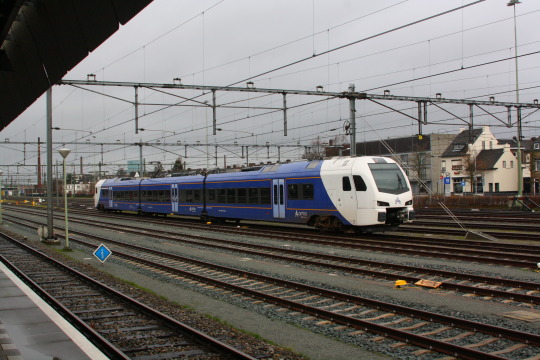
The FLIRTs for this service are specially equipped for the line, supporting all the different voltages in the overhead lines and all the other necessary support systems… almost. That’s going to become important later.
(Arriva Nederland Limburgs also has other trains, including other FLIRTs, that are only equipped for the Netherlands. I'll ignore them here.)
Services started in December 2018, theoretically. In practice the German leg of the service didn’t work yet. The problem was that the line from Heerlen to Herzogenrath (and then further to Aachen) used to be one of the few non-electrified lines in the region. It was electrified specifically for the RE18, and the work wasn’t quite finished yet. That got resolved, though, and the train is now working mostly well between Germany and the Netherlands. There are still some issues, like how it consistently announces that the doors will open on the left when they will open on the right and vice versa, but those are minor issues. The main problem for me is that it bypasses the Ikea station instead of stopping there.
The much bigger problem was the Belgian line, from (south of) Maastricht to Liège. The Belgian railway authorities were never that enthusiastic about the project to begin with, seeing how it was a private dutch company (though owned by the German government), and the platforms in the intermediate station of Visé were too low for step-free access and needed to be rebuilt. But the real main issue lay elsewhere: The new trains did not have ETCS.
Train control systems
We need a detour here about train control systems. Trains are controlled by signals. If a train passes a red signal, an accident usually follows, so over time every country developed different systems to make sure that doesn’t happen. The specific features of these vary widely. Some just warn the engineer that a red signal is ahead, and stop the train if the engineer doesn’t react. Some activate the emergency brake when the engineer passes a red signal, or when they don’t brake enough. More advanced ones for high speed lines tell the engineer the current allowed speed, upcoming speed changes and how far away they are, like a mini-GPS system, and constantly check that the engineer is driving within these limits. Many systems do a combination of different things.
Almost every country has its own of these systems, generally known by a cryptic abbrevation, and many countries have several. For example, Germany has PZB for all lines and additionally LZB for high-speed lines. The Netherlands have different versions of ATB, Belgium has TBL1+ and so on. The differences between them aren’t relevant for this post, but they’re all very different in what they do and how they do it. The RE 18 trains support all of them, except LZB because they’re not used on lines that make it necessary.
That’s expensive and annoying, so the European Union and European rail industries have developed a new system to replace all of them, the European Train Control System or ETCS. You will also hear the term ERTMS (European rail traffic management system), which includes ETCS and some other things, but in common parlance it usually means the same thing. Despite the name, it is also heavily used outside of Europe, e.g. on China’s high speed rail network.
And yes, that is very much a situation like the classic XKCD comic:

Source: XKCD 927, CC-BY-NC 2.5
(For americans reading this and wondering about PTC: That is a whole mess and almost everyone, including Wikipedia, explains it wrong, but for the purposes of this post we can just say that these systems and in particular ETCS are all something „like“ PTC.)
ETCS will only make sense once all European mainlines are equipped with it, which is still several decades away. But some countries are working harder than others to implement it. In particular, Belgium demands that all new trains since about 2015 have ETCS. Including the Stadler FLIRT for the RE 18.
In this case
The operator protested, because that requirement apparently came in while the trains were in production, and the line in question didn’t even have ETCS at the time (according to the latest Belgian maps it does now). To this day, the trains actually running there, as a Liège-Maastricht shuttle, do not have ETCS. So clearly it's not that essential… yet. Still, Belgian authorities refused to budge, so the trains had to be sent back to the manufacturer to get ETCS installed.
(Aside: ETCS is an open standard, and you can get ETCS equipment both for the tracks and for the trains from many different companies. Stadler, the manufacturer of these trains, only recently got into making ETCS equipment. Before that they had to buy it from competing train makers. These trains are among the first equipped with Stadler’s ETCS solution.)
The first train got it installed, returned to the line, and started tests. It worked well in the Netherlands, it worked well in Germany, it ran into Aachen station and worked well there, it ran back out of Aachen station and it stopped. Full emergency stop. After some testing it was determined that it always does an emergency stop when running out of Aachen station. And nobody is really sure why.
The low-down
We can make some vague guesses, though, because Aachen main station does have some ETCS equipment.

ETCS works partially with radio, but also with what are functionally giant RFID tags, the same basic concept like what you’ll find on a wireless credit card. They’re working at different frequencies and they’re designed for reliable reading at 450 km/h, but the basic idea is pretty much the same. These tags, known as „Balise“ (French for beacon) or Eurobalise, are mounted in the middle of the track, and are often yellow, at least when new. They can either send the same data every time, or be controlled with a cable from a computer.
Not everybody loves ETCS, but everybody seems to like the Eurobalise. It’s simple technology that can transmit a lot of information, and so there are a number of non-ETCS uses for it.
One such use case is transmitting the information of an older train control system. That is what the Belgians do with their TBL1+ system. It’s the same system as TBL1 (there is also a TBL2, but that was a bad idea and is gone now), but it transmits its information with Eurobalises. The idea is that you update these balises later to also transmit ETCS signals. Older trains can just get a balise reader, newer trains can just get ETCS, and you have only a single type of thing in the track instead of two. Switzerland is the first country that is fully ETCS equipped thanks to such a strategy, and Belgium is following suit.
The other use case is the "ETCS-based class B transition". Sounds tough but really isn’t: ETCS has a mechanism to tell the train, "hey, ETCS is ending, switch to ATB/PZB/TBL/…". In this context "Class B" means any system that isn’t ETCS (and that is on the list of things that ETCS knows about, for this purpose). The system ensures that the train really does switch to the other system, and that it stops if the switch doesn’t work. That is very useful and so most border crossings at least in Germany use it these days, even if no other part of ETCS is seen anywhere.
Both of these use cases are well established and ETCS specifically allows for them. Aachen central station is particularly fun because here you will find both of them combined. It is the border station for (passenger) trains to Belgium, so several tracks can be switched to Belgium mode, with Belgian electricity, and with Belgian TBL1+ train control system. The Eurobalises in these tracks pull double duty: They tell trains whether to switch to Belgian or German train control systems, depending on where the route is set, and if the Belgian system is to be used, they also transmit the information from that.
This isn’t new, and has worked well for years. The only other two types of passenger trains approved for the Netherlands, Belgium and Germany (and in one case also France), the Thalys PBKA and the ICE 3M high speed trains, also run through this station and they also have ETCS equipment and it all works.
But something about the combination together with the ETCS equipment in the new trains just doesn’t mesh well. It’s possible that there’s a bug in the software of the train. It’s possible that there’s a bug in the coding of the balises. Maybe it's something else; ETCS is a complex standard with a lot of updates, and the equipment in Aachen hasn't been touched in a while.
A theory I read on a dutch forum said that these balises tell the train to switch to combined PZB+LZB mode, but the train only has PZB mode and gets confused. I don’t know enough about ETCS to know whether this is plausible (and I know way too much about this stupid system already). All we really know for sure is that there are people working on this, and they're not telling us any of the details.
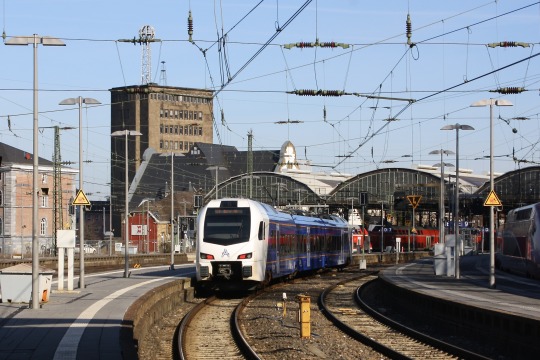
But after a few days where the train just didn’t run to Aachen at all, they found a solution. You know how I said that some tracks can be switched to Belgium mode? The others can’t, so why not just run the train into those?
That was actually easier said than done. Aachen has a lot of tracks, but most of them are used for parking trains. Most German regional trains to Aachen end in Aachen, and then wait here for half an hour or so until they return to where they came from. This isn’t required by the track layout or anything, it’s just convenient because that way, delays don’t build up quite as much. And the best location for that pause is, of course, right at the edge of the country. Centre of Europe? Yeah, sure, whatever…
So the solution is now that the RE18 runs into track 3 and stops in the middle of the platform, where it unloads all passengers. Then it drives forward to the end of the platform, and stays there. Another train, the RB33, pulls in behind it (there’s a red signal between them, don’t worry), and waits for its time to depart. Eventually it does, and shortly thereafter, the RE18 runs back to the middle of the platform, and then a few minutes later, back out again. It’s a silly little dance, but so far nobody has found a better solution.

(Before you start, the end of platform 3 is very narrow and at a non-accessible height, so the train can't just load and unload there.)
As for the Belgian side of things, through-services to Liège will start this December! Woohoo! It seems this thing is finally working.
The Future
The long-term hope is to turn this from an hourly to a half-hourly service. It already is for most of its length, but right now the trains stop in Herzogenrath, just after the German border, because there is no space in the schedule to run them to Aachen yet.
Another hope is to create a completely new service from Aachen to Eindhoven, also using the same trains. Eindhoven wants to be connected to the German ICE network, Aachen wants to be connected to the dutch train network, so this sounds all great. Personally, I have doubt that these trains have enough capacity, but they are currently the only ones that would work. An issue with that is the actual line over the border. This used to be double-tracked, then got single-tracked. Now they want to double-track it again, but when it was electrified, they put the power poles right where the second track used to be. Not sure what they were thinking there.
All of these projects will take years, if not decades, and have in fact already taken years or decades. I’ve been in Aachen since 2007, and things like electrifying the line over the german-dutch border or creating a direct train from Aachen to the center of the Netherlands (or at least Eindhoven) have been in discussion for at least since then. On the one hand, it’s frustrating how slowly all these things are going. On the other, they are happening at all, and looking back ten years or so, it’s quite nice to see what has been accomplished.
I guess my one wish is that they’d finally let the train stop in Heerlen Woonboulevard, I’m tired of changing trains to get to Ikea.
24 notes
·
View notes
Text

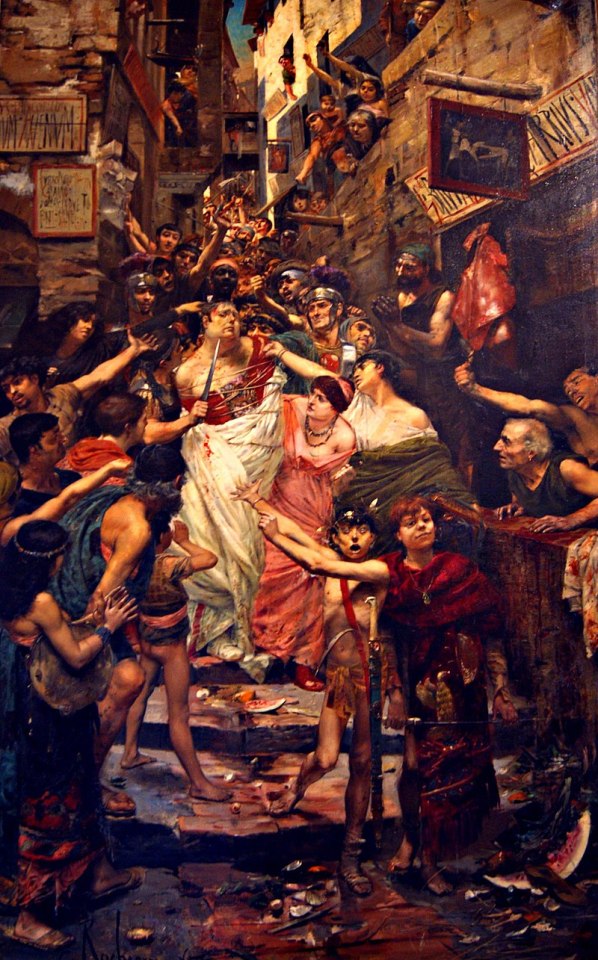
On 24 September 15 AD, Aulus Vitellius, one of the emperors from 69 AD (the year of 4 Emperors) was born. Here are some facts about Vitellius:
When his parents saw his horoscope, they were so horrified they tried to keep him from governing a province or commanding an army.
In his youth, he was a guest of Emperor Tiberius on Capri and the most malicious rumors say that he was one of the emperor's tiddlers - boys trained to sexually please him - which in turn won political advancement to Aulus's father Lucius.
Galba named Vitellius commander of the Rhine legions because he believed he was too lazy and incompetent to lead a rebellion and declare himself emperor.
He was the only one who didn't take the name Caesar as part of his regnal name, choosing Germanicus instead.
He allegedly feasted four times a day. Extravagant dishes like pheasant brains and flamingo tongues were served at these feasts.
When his army was defeated by Vespasian's legions, he tried to abdicate but his supporters wouldn't let him.
After his final defeat, he tried to hide but was dragged by an angry jeering mob to Gemonian stairs and savagely killed. His head was then paraded through the streets of Rome and his body was thrown into the Tiber.
13 notes
·
View notes
Text

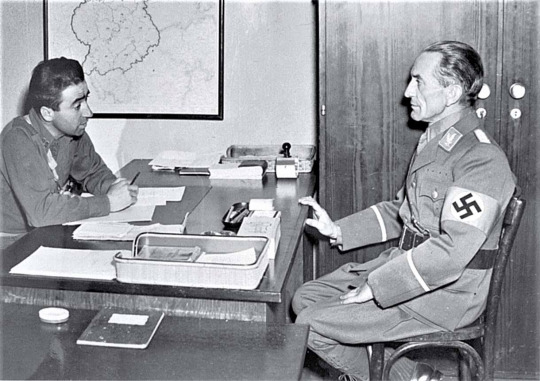
Johann „Hans“ Friedrich Goebbels - Joseph’s brother
(I found the pics here and here)
Comment from German Wiki on Hans' career:
“The brothers of the great men quickly make careers in the Third Reich. They don't need to be particularly skilled; it's enough that they are brothers. The classic case, so to speak, is Mr. Hans Goebbels, the brother of the propaganda minister. Before the creation of the Third Reich, he was a simple insurance agent. But National Socialism had not yet dominated the German Reich for two years when he has already been earning the handsome salary of a general director of the Provincial fire and life insurance institutes of the Rhine Province in Düsseldorf.”
– Article in Der Tag from April 19, 1935[link]
I wonder whether Hans Goebbels deliberately made his looks to be as close to his brother's as possible? Like so that no one (even who meets him for the 1st time) had doubts of whose relative he is? :)
13 notes
·
View notes
Text
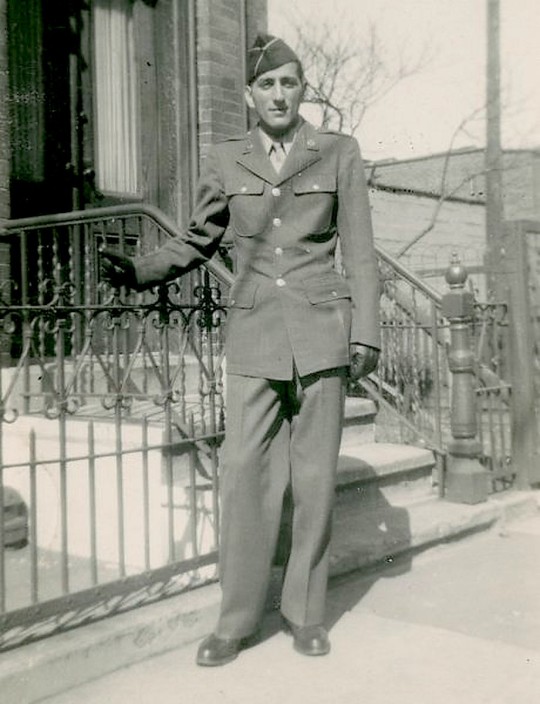
Tony Bennett
Anthony Dominick Benedetto, United States Army
63rd Infantry Division
August 3, 1926 – July 21, 2023
Tony Bennett was an American singer. Bennett amassed many accolades throughout his career, including 20 Grammy Awards, a Lifetime Achievement Award, and two Primetime Emmy Awards. He was named an NEA Jazz Master and a Kennedy Center Honoree, and was the founder of the Frank Sinatra School of the Arts in Astoria, Queens, New York. Bennett sold more than 50 million records worldwide.
Tony Bennett had come a long way since growing up poor in Queens, New York, during the Great Depression. Born Anthony Dominick Benedetto in 1926 to Italian immigrants, Bennett's father was a grocer who died when Tony was 10 years old. It wasn't long before he started helping out the family by singing while waiting tables.
Like many people and many families, the Benedettos' lives were forever changed by World War II.
Bennett turned 18 in 1944 and was drafted into the U.S. Army.
By March 1945, the young soldier was deploying to Europe with the 63rd Infantry Division, replacing casualties lost in the Battle of the Bulge. In his 1998 autobiography "The Good Life," he called the war a "front row seat in hell."
As the German Army was pushed back, Benedetto and his company saw bitter fighting in cold winter conditions, often hunkering down in foxholes as German 88 mm guns fired on them.
At the end of March, they crossed the Rhine and entered Germany, engaging in dangerous house-to-house, town-after-town fighting to clean out German soldiers; during the first week of April, they crossed the Kocher River, and by the end of the month rea ched the Danube.
During his time in combat, Benedetto narrowly escaped death several times. The experience made him a pacifist he would later write, "Anybody who thinks that war is romantic obviously hasn't gone through one,"and later say, "It was a nightmare that's permanent. I just said, 'This is not life. This is not life.'"
At the war's conclusion he was involved in the liberation of the Kaufering concentration camp, a subcamp of Dachau, near Landsberg, where some American prisoners of war from the 63rd Division had also been held. He later wrote in his autobiography that "I saw things no human being should ever have to see."
Benedetto stayed in Germany as part of the occupying force but was assigned to an informal Special Services band unit that would entertain nearby American forces. His dining with a black friend from high school—at a time when the Army was still racially segregated—led to his being demoted and reassigned to Graves Registration Service duties.
Subsequently, he sang with the 314th Army Special Services Band under the stage name Joe Bari (a name he had started using before the war, chosen after the city and province in Italy and as a partial anagram of his family origins in Calabria). He played with many musicians who would have post-war careers.
Upon his discharge from the Army and return to the States in 1946, Benedetto studied at the American Theatre Wing on the GI Bill. He was taught the bel canto singing discipline, which would keep his voice in good shape for his entire career. He continued to perform wherever he could, including while waiting tables. Based upon a suggestion from a teacher at American Theatre Wing, he developed an unusual approach that involved imitating, as he sang, the style and phrasing of other musicians—such as that of Stan Getz's saxophone and Art Tatum's piano—helping him to improvise as he interpreted a song.He made a few recordings as Bari in 1949 for small Leslie Records, but they failed to sell.
12 notes
·
View notes
Note
Super random question, but is there like an actual history about how the kippah (the piece of clothing itself not the meaning) developed, because so far I've kinda headcanon'd it came from balding men wanting to protect their bald spot from the sun. It also always seems so flimsy, how are guys not losing it all the time?
Bfhdhdjdjsjs your headcanon is A++.
Tbh, I had to look it up, since despite thinking about it when I was younger, I never bothered to look it up. According to Jewish encyclopedia, through Wikipedia,
The Israelites might have worn a headdress similar to that worn by the Bedouins, but it is unknown whether a fixed type of headdress was used. That the headdress of the Israelites might have been in the fellah style may be inferred from the use of the noun צַנִיף, tzanif (the verb tzanaf meaning "to roll like a ball", Isaiah 22:18) and by the verb חַבָּש, habash ("to wind", compare Ezekiel 16:10; Jonah 2:6). As to the form of such turbans, nothing is known, and they may have varied according to the different classes of society. This was customary with the Assyrians and Babylonians, for example, whose fashions likely influenced the costume of the Israelites—particularly during and after the Babylonian Exile.[42] [...]
I imagine that, at the beginning, it was meant to protect the skin from the sun's heat, like the Bedouin used it, and given what is customary within Babylonian and Assyrian societies, it probably had also a role in distinguishing your social class (which is still sort of a thing! For insurance, in general black kippahs are a staple of Haredi Jews). That being said, on the Assyrian stelees Jews are not shown to wear any kind of head dress, which might mean they weren't in vogue during that time (or that the one making the stelee got lazy ��).
Now, as for the change into a skullcap, I imagine it was a change in fashion, which stuck for the longest and thus became the norm, yet it still differs among different Jewish communities:
The Black Velvet Kippahs are, as I said, of the ultraorthodox Jews, and even they have variation: See how one has a rim and one doesn't.



Haredi children might also have velvet Kippahs with embroidery or other colors such as navy blue.
Yemenite Kippahs tend to have a dark color and embroidery at the bottom, while there are also knitted Kippahs used by less orthodox factions of Judaism, and they come in many colors and many designs.
In other words, it's either a community thing (think breslov, bukharan Jews, and haredim) and/or a fashion thing (think suede and crochedet Kippahs used by reform and modern Orthodox Jews).


A good guide for this sort of thing is this the following image, which shows a series of changes of Jewish male headdress

Jewish Head-Dress at Various Periods.1, 2. England (13th cent.). 3-5. Germany (13th cent.). 6-8. France (13th cent.). 9. Rhine Provinces (13th cent.). 10. Constance (1417). 11. Holland (15th cent.). 12. Italy (15th cent.). 13, 14. Germany (15th cent.). 15-17. Rhine Provinces (15th cent.). 18, 19. Worms (16th cent.). 20. Germany (16th cent.). 21. Worms: "Judenbischof" (17th cent.). 22. Swabia (17th cent.). 23. Frankfort-on-the-Main (1630). 24, 25. Poland (1765). 26, 27. Warsaw (1825). 28. Cracow (17th to 18th cent.). 29. Podolia (1750). 30. Tunis (1800). 31. Morocco (1800). 32. Moravia (1800). 33. Russia (modern). 34. Caucasus (modern). 35. Russia: Karaite (modern). 36, 37. Tunis (modern). 38. Russia: "Yarmulka" (modern). 39. England: rabbinical (modern).
As you can see, the headdress changed a LOT until it reached today's look, which is probably a product of changes in fashion, price of fabric, and probably also emancipation etc. and the desire to blend in better into gentile societies.
Then again, I'm no expert so I might be spewing nonsense XD.
Anyway, I hope this was helpful to some degree!!
10 notes
·
View notes
Photo

François Musin - On the beach at Katwijk -
oil on panel,
Katwijk, also spelled Katwyk, is a coastal municipality and town in the province of South Holland, which is situated in the mid-western part of the Netherlands.
The Oude Rijn ("Old Rhine") river flows through the town and into the North Sea.
Katwijk is located on the North Sea, northwest of Leiden and 16 km north of The Hague. It shares its borders with the municipalities of Noordwijk, Teylingen, Oegstgeest, Leiden, and Wassenaar. In August 2020, Katwijk had a population of 65.929 and covers an area of 31.15 km2 (12.03 sq mi), of which 6.40 km2 (2.47 sq mi) is water. Katwijk is by far the largest town in the Duin- en Bollenstreek ("Dune and Bulb Region").
Katwijk is a seaside resort with a wide sandy beach. Its attractiveness is mainly due to its laid-back atmosphere. The boulevard along the shore is not spoiled by large hotels or apartment blocks and has not given in to an excessive commercialisation. Although most buildings lining the boulevard are tourist apartments and pensions, most are just three floors high (and none more than five) and offer a distinctive 'feel' of the 1950s. Besides the beach, there are a few museums in Katwijk, like the old fisherman's museum Katwijks Museum and the Spinoza-museum. A few kilometers inland is the Valkenburg Lake Steam Train, a narrow-gauge railway museum where a scenic steam locomotive driven train ride can be taken around Lake Valkenburg. Katwijk has many hotels and three camping places, mostly situated in the dunes.
François-Etienne Musin (4 October 1820, Ostend - 24 October 1888, Saint-Josse-ten-Noode) was a Belgian painter who specialized in seascapes and scenes of coastal landscapes, rivers and harbours.
Musin's father was an innkeeper, shipbuilder and oyster farmer who had spent some time in a penal regiment for desertion during the Napoleonic Wars. As a child, he paid more attention to the sea than his studies. His artistic talent was discovered when he was locked in the attic as punishment and used a piece of charcoal to draw a view of the Ostend docks on the wall.
In 1831, he received his first lessons from Michel Van Cuyck and François-Antoine Bossuet, who would later become famous for his vedute, but was still working for the Port of Ostend at that time. He later attended the local Beaux Arts Academy and graduated after winning a gold medal in 1835. By this time he had already gained some dangerous experience with ships and sailing while tending to his father's oyster beds.
He continued his studies at the Académie Royale des Beaux-Arts in Brussels, where he studied under François-Joseph Navez. While there, he made drawings of surgical procedures in the operating room of Doctor Louis-Joseph Seutin, with the intention of publishing them in a textbook. In 1839, he was drafted in the Army, but his father paid for a replacement (a common practice at the time). In 1840, he began to exhibit and moved to Brussels permanently in 1842, completing his studies the following year. His career was substantially advanced when King Leopold I bought two of his paintings in 1845.
21 notes
·
View notes
Text
Deutschribing Germany
History
During most of its history, Germany was divided into several duchies, principalities, free cities, and ecclesiastical states.
Prehistory and ancient history
Germany is famous for the discovery of Homo neanderthalensis bones, as well as for having the oldest complete set of hunting weapons in the world, the oldest figurative work of art (Löwenmensch figurine), and the oldest figurative object (Venus of Hohle Fels). The latter two are attributed to the Aurignacian culture.
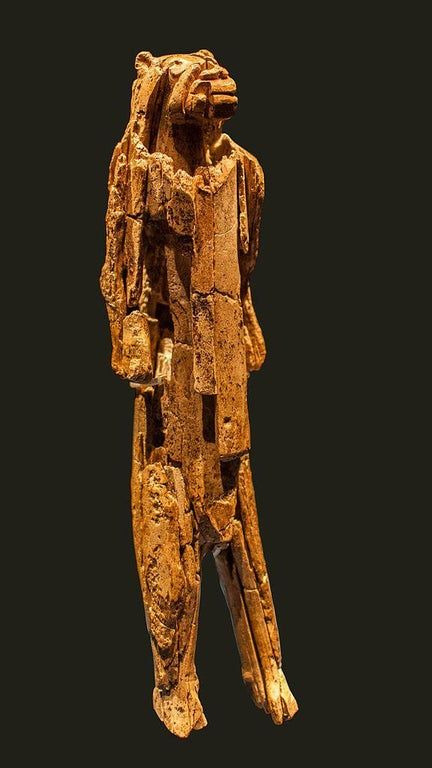
The country’s ancient history is characterized by the expansion of Germanic peoples, including the Alemanni, Franks, Goths, and Saxons. Around the same time, the Roman Empire started to invade Germanic lands, creating the province of Germania between the Rhine and Elbe rivers. Eastern Germany was inhabited by Western Slavic tribes.
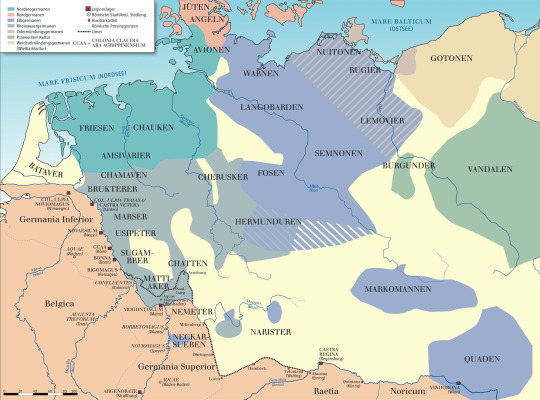
Middle Ages
The most powerful Germanic tribe, the Franks, eventually conquered many of the others, and in 800, their king Charlemagne founded the Carolingian Empire, which was later succeeded by the Holy Roman Empire, absorbing northern Italy and Burgundy.

Meanwhile, north German towns in the Hanseatic League prospered thanks to trade. This dynamic climate was the background for the invention of the printing press by Johannes Gutenberg.
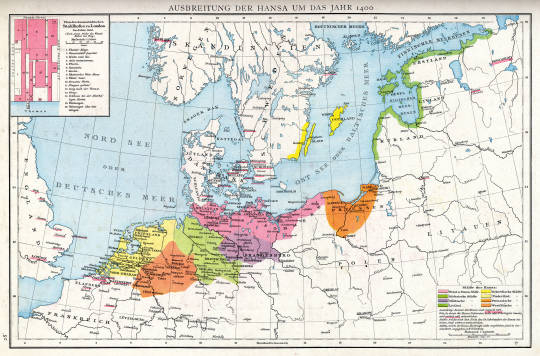
Modern history
Germany’s modern history is characterized by division, first due to religion and then as a result of the fight for political power. Following Martin Luther’s Protestant Reformation in 1517, religious conflict between Roman Catholics, Lutherans, and Calvinists devastated the country, especially during the Thirty Years’ War (1618-1648). The Peace of Westphalia ended religious warfare by allowing each state in the Holy Roman Empire to choose their official religion.

During the following two centuries, the Austrian Habsburg monarchy and the Kingdom of Prussia fought for dominance, eventually annexing free cities and ecclesiastical territories. Together with France and Russia, they competed for hegemony in present-day Germany during the Napoleonic Wars.
Following the fall of Napoleon, the 1815 Congress of Vienna founded the German Confederation, with the Austrian emperor as the permanent president. The revolutions of 1848 led to the rise of the German question, and King Frederick William IV of Prussia was offered the title of emperor but rejected it. In 1862, Otto von Bismarck was appointed as the Minister-President of Prussia and eventually defeated Austria and France. After the latter defeat, the German Empire was founded in 1871, with Prussia as the dominant constituent state and Bismarck forging alliances with Austria-Hungary and Italy.
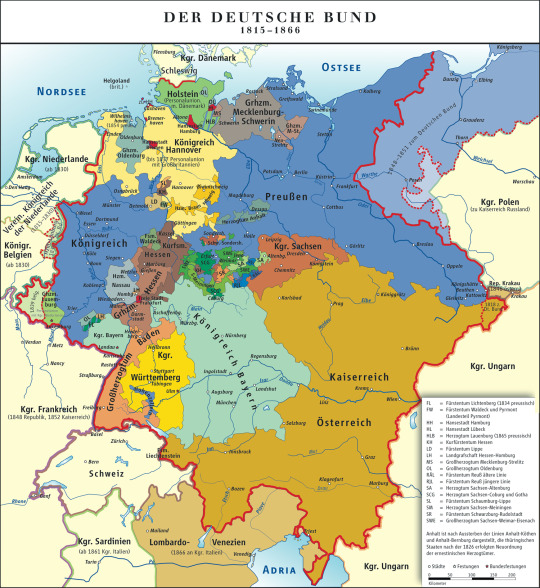
Contemporary history
When Archduke Franz Ferdinand of Austria was assassinated in 1914, Austria-Hungary declared war on Serbia, triggering World War I, which ended with Germany’s defeat and the Treaty of Versailles of 1919, because of which it lost many European territories and all of its possessions in Africa and the Pacific. The humiliation brought about by the Treaty is seen as influential in the rise of Adolf Hitler.
After the war, the Weimar Republic was established, during which there was a period of political instability and hyperinflation. The Nazi Party led by Hitler rose to power in 1932 as a result of high unemployment levels caused by the austerity and deflation policies put in place following the Great Depression. In 1933, Hitler obtained unrestricted legislative power and Germany became a totalitarian state. The regime created concentration camps for the internment of minorities, such as the Jews, Romani people, disabled people, homosexuals, and political opponents, rearmed its army, and implemented a program for economic renewal. In 1939, Germany invaded Poland, a move that started World War II. Following Hitler’s suicide, Germany surrendered, and the war ended.
The Allies, which had won the war, divided the country and its capital city into four occupation zones. In 1949, the western sectors, controlled by France, the United Kingdom, and the United States merged to form the Federal Republic of Germany (Bundesrepublik Deutschland) or West Germany. The Soviet zone became the German Democratic Republic (Deutsche Demokratische Republik) or East Germany. Konrad Adenauer was elected the first federal chancellor that same year. Both German states were reunified on October 3, 1990, following the fall of the Berlin Wall. East Germany joined the European Union as part of united Germany.
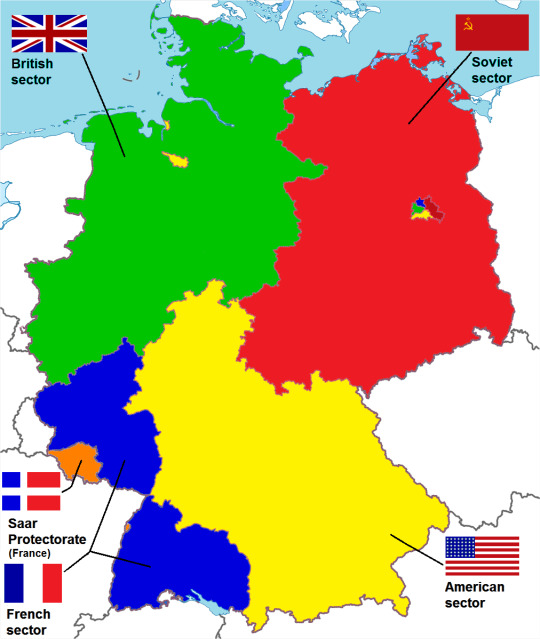
In the 2005 elections, Angela Merkel became the first female chancellor. She ruled the country until 2021.

4 notes
·
View notes
Text







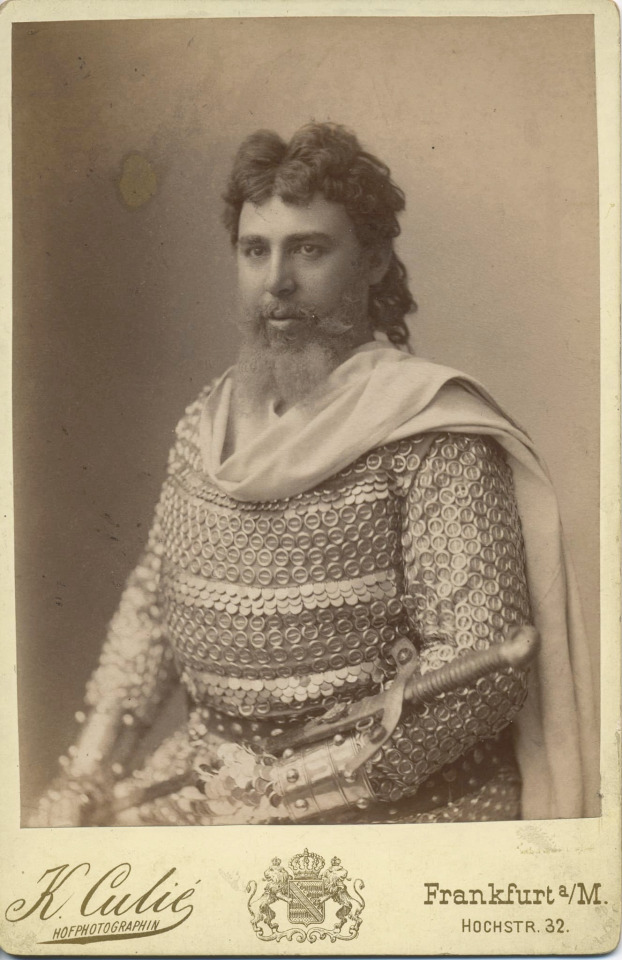





On June 10, 1865, the world premiere of "Tristan and Isolde" by R. Wagner took place in Munich.
„Isolde… wie schön…“
Here are some of the first tenors to have sung the role of Tristan over the years and contributed to the success of this work through their dedication.
Erik Schmedes (27 August 1868, in Gentofte, Denmark – 21 March 1931, in Vienna), Danish heldentenor.
Alois Pennarini (Vienna 1870 - Liberec, Czechoslovakia 1927), Austrian-Hungarian first spinto tenor then heldentenor.
Modest Menzinsky (29 April 1875 in Novosilky, Galicia - 11 December 1935 in Stockholm), Ukrainian heroic tenor.
Karl Kurz-Stolzenberg
Adolf Gröbke (May 26, 1872 Hildesheim - September 16, 1949 Epfach), German tenor.
Iwan Ershov (November 8, 1867 – November 21, 1943), Soviet and Russian dramatic tenor.
Alfred von Bary (January 18, 1873 in Valletta, Malta - September 13, 1926 in Munich), German tenor.
Alexander Bandrowsky (April 22, 1860 in Lubaczów - May 28, 1913 in Cracow), Polish Tenor.
Jacques Urlus (6 January 1867 in Hergenrath, Rhine Province – 6 June 1935 in Noordwijk, Netherlands), Dutch dramatic tenor.
Francesc Viñas (27 March 1863 – 14 July 1933), Spanish tenor.
Richard Schubert (Dessau, Germania; December 15, 1885 - Oberstaufen, Germania; October 12, 1959), German tenor.
Dr. Julius Pölzer (April 9, 1901 in Admont - February 16, 1972 in Vienna), Austrian tenor.
Giuseppe Borgatti (Cento, 17 March 1871 – Reno di Leggiuno, 18 October 1950), dramatic tenor. (with Magini-Coletti as Kurwenal)
Antonio Magini-Coletti (17 February 1855 – 21 July 1912), Italian baritone.
#opera#classical music#music history#bel canto#composer#classical composer#aria#tenor#classical studies#Tristan and Isolde#classical musician#classical musicians#musician#musicians#classical history#historian of music#history#maestro#chest voice#Tristan und Isolde#Richard Wagner#Wagner#classical singer#classical singing#opera history#music#classical
4 notes
·
View notes
Photo

Otto Albert Koch: Varus Battle, 1909
The Battle of the Teutoburg Forest, described as the Varian Disaster (Clades Variana) by Roman historians, took place at modern Kalkriese in AD 9, when an alliance of Germanic peoples ambushed Roman legions and their auxiliaries, led by Publius Quinctilius Varus. The alliance was led by Arminius, a Germanic officer of Varus's auxilia. Arminius had acquired Roman citizenship and had received a Roman military education, which enabled him to deceive the Roman commander methodically and anticipate the Roman army's tactical responses.
Teutoburg Forest is commonly seen as one of the most important defeats in Roman history, bringing the triumphant period of expansion under Augustus to an abrupt end. The outcome of this battle dissuaded the Romans from their ambition of conquering Germania, and is thus considered one of the most important events in European history. The provinces of Germania Superior and Germania Inferior, sometimes collectively referred to as Roman Germania, were subsequently established in northeast Roman Gaul, while territories beyond the Rhine remained independent of Roman control. Retaliatory campaigns were commanded by Tiberius and Germanicus and would enjoy success, but the Rhine would eventually become the border between the Roman Empire and the rest of Germania. The Roman Empire would launch no other major incursion into Germania until Marcus Aurelius (r. 161–180) during the Marcomannic Wars.
Some of the descendants of the vassal kingdoms, like the Suebi (by suzerainty), that Augustus tried to create in Germania to expand the romanitas and the Empire in a peaceful way would be the ones that invaded the Empire in the fourth and fifth centuries.
#Battle of the Teutoburg Forest#Varian Disaster#Arminius#Publius Quinctilius Varus#AD 9#roman empire#german history#ancient roman history#Otto Albert Koch#paintings#art#arte#XX century
2 notes
·
View notes
Photo
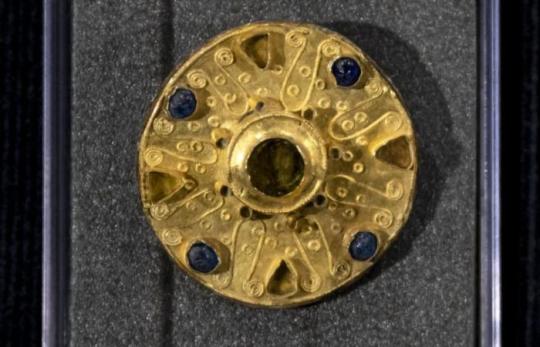
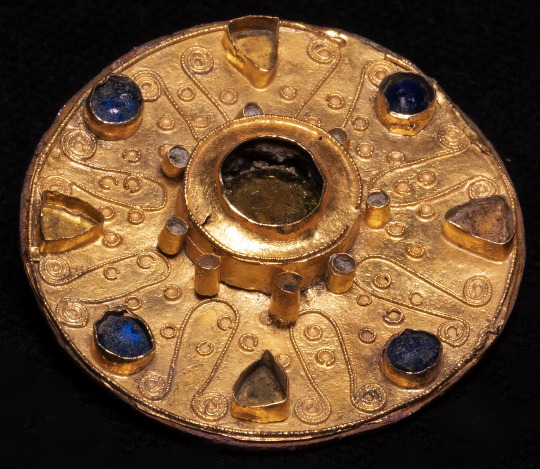
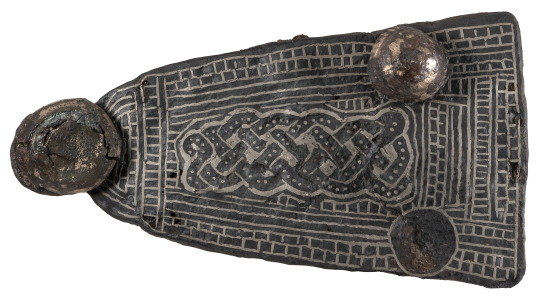
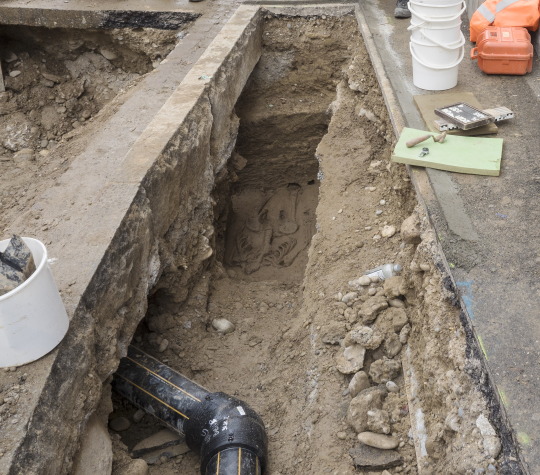
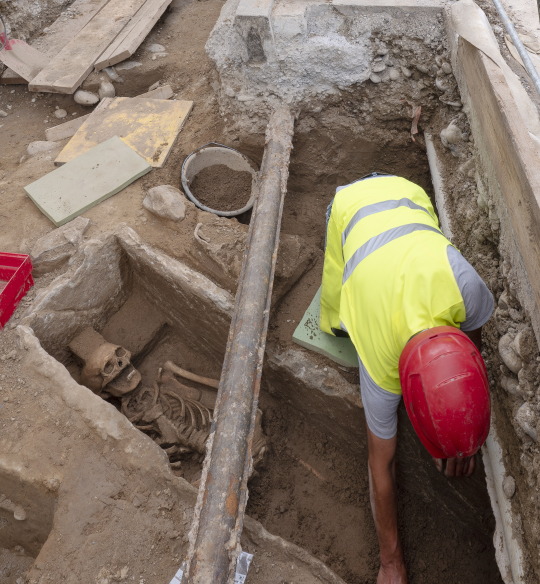

Medieval Tombs with Gold Jewelry Found in Switzerland
An excavation of the Kleinbasel neighborhood of Basel, Switzerland, has brought to light 15 graves, some of them richly furnished, from an early medieval burial ground. The presence of a burial ground from this period had been known since the 19th century, so a rescue archaeology excavation was undertaken in the area before installation of new utility pipes. Earlier this year the excavation unearthed the 6th century grave a young girl buried with a dazzling array of about 380 beads. The recent discoveries prove that the cemetery was more densely populated than archaeologists realized.
One of the highlights of the newly-discovered graves is that of an elite young woman who was about 20 years old when she died in the 7th century. The grave was damaged during construction in the early 20th century. The skull is lost, as is the body below the knees, but the riches she was buried with remain. The grave contained a rare gold disc brooch made of a base plate made of a non-ferrous metal that was then topped with gold. The disc was then adorned with gold wire filigree and inlayed with green garnet gemstones and blue glass. The brooch likely held together a cloak, now gone, at her neck. She was also wearing a necklace made of 160 glass, amethyst and amber beads (or had them sewn onto the collar or bodice of her garment). There was also a leather strap decorated with metal crosses that terminates in a large amber pendant. Around her waist was a belt with an iron buckle and a silver tongue. Hanging from the belt was a chatelaine with pierced Roman coins, metal artifacts and a bone comb.
Other notable graves found in the current excavation include a child’s grave containing a large silver inlay belt buckle, metal belt fittings, scissors and a comb, and a stone cist grave containing the skeleton of an adult man. The man’s face bears the unmistakable evidence of violent blow from a sword. Amazingly, the man survived the disfiguring injury as he died after it was fully healed.
Basel was founded as a Celtic oppidium, or fortified settlement, in the 1st century B.C. The Romans built a military camp on the site of the settlement and by the end of the 1st century A.D., it was absorbed into the Roman province of Germania Superior. Roman control weakened in the 3rd century, but the troops along the Rhine managed to repel invasions from the Germanic Alemanni confederation several times in the 4th century. The Alemanni finally won around 406 A.D., settling throughout the Swiss Plateau. They and the Franks after them occupied the old Roman castle and the town’s fortunes were revived. It was minting its own coins in the 7th century and was made a bishopric in the 8th. The Roman castle was converted into Basel’s first cathedral. What is today the Kleinbasel area was the castle/cathedral hill, the nucleus of the early medieval settlement.
#Medieval Tombs with Gold Jewelry Found in Switzerland#basel switzerland#ancient tombs#ancient graves#ancient artifacts#gold#jewelry#history#history news#ancient history#ancient culture#ancient civilizations
174 notes
·
View notes
Text


HAPPY EASTER ON THE WESTERN FRONT -- PREPPING EASTER EGGS FOR THE ENTIRE WEHRMACHT.
PIC(S) INFO: Spotlight on a WWII-era photograph titled "Easter Eggs for Adolph," taken on March 10, 1945, during the Battle of Remagen, Rhine Province, Germany.
OVERVIEW: "Technical Sergeant William E. Thomas and Private First Class Joseph Jackson preparing a gift of special “Easter Eggs” for Adolph Hitler and the German Army. Scrawling such messages on artillery shells in World War II was one way in which artillery soldiers could humorously express their dislike of the enemy."
-- WIKIMEDIA
PIC #2: The "colorized" version of the same photograph.
Sources: www.reddit.com/r/OldSchoolCool/comments/a1inl5 & Wikimedia.
#World War II#World War 2#WW2#Western Front#Western Front 1945#European Theatre of War#War is Hell#Easter Eggs#Happy Easter#U.S. Army#US Army#German Army#Wehrmacht#European Theater of War#Germany#Military History#Battle of Remagen#1940s#Easter Eggs for Adolph#Europe#War photography#Photography#WWII#Hell is War#Forties#Easter#40s
0 notes
Text
[ad_1]
Gawking at a twinkling Eiffel Tower, cramming into the Mona Lisa’s tiptoeing crowd, and tipsily serenading passers-by in scant French à la Moulin Rouge are some of France’s famed first-time experiences – well, they were mine, anyway. But if you’re aspiring for more than a pre-prepared, Paris-heavy checklist, you’ll want to venture beyond the crème de la crème capital to embrace all of that France has to offer.
Oui, the world’s most visited country has an Eiffel Tower-sized list of activities, something I can attest to after a dozen or so visits. Powderchasers should beeline to the southeast for perfect winter pistes, summer sun-seekers can sizzle on the seductive southern shorelines of the Cote d’Azur or Corsica, while history-inclined travellers will find stories along Normandy’s D-Day beaches and its isolated island abbey.
And then there’s all that food and wine. Oh là là! Diving into France’s joie de vivre is as effortless as devouring your way through some of Europe’s best food cities, such as bouchon-heavy Lyon or perfectly wine-paired Bordeaux. But the menu doesn’t end there. From flitting between lavender blooms to micronation border-hopping, these are my picks of the best things to do in France.
Taste your way through an appellation (or two)
Madame et monsieur, what will it be? An oaked Chablis, light and fresh Beaujolais, or a criminally good Châteauneuf-du-Pape? Whichever you order, you’ll be embracing one of France’s best experiences: sampling a selection of the world’s finest wines. But in addition to popping corks at closely huddled tables, factor in a delicious Domaine visit, a boozy wine marathon, or an overnight vineyard stay to exhaustively appreciate the land of award-winning vintners and seriously credential-clad sommeliers.
Settling into a tasting room, perhaps in a château or a more humble farmhouse, is the quickest way to gain intimate knowledge of France’s top-notch vins. When I worked in a French restaurant in London, one of the job’s greatest joys was occasional trips across the channel to meet knowledgeable makers and hand-select new vintages for the wine list – an essential “research experience” I think everyone should build have. And you won’t even have to travel far to say santé amongst the vines. Wineries are everywhere.
There are the most famous appellations, of course, such as Bordeaux and Champagne – less than two hours from Paris – but don’t overlook the likes of Alsace, easy to explore if you’re at Colmar’s Christmas markets, or the very palatable rosés of Province’s vines, a perfect detour on a French Riviera road trip. The bad news? A designated driver in France is a must.
View from the scenic Bordeaux to Bergac train which slices through vineyards
Embark on a river cruise
L’Hexagone is handsome from all angles, but perhaps even more so when cinematic castles and Cézanne-inspiring countryside unhurriedly glide by. For a trip with distinction – one free of traffic and hotel-hopping – why not explore France’s highlights on a river cruise? Like the country’s wine list, the waterway prospects are extensive, with cruises along the Dordogne, into the Loire Valley, or tracing the border-crossing Rhine all bundling many of France’s best experiences into one dreamy getaway.
The most obvious first-time route would be a Seine river cruise from Paris. Leaving the city of love in your wake, a one-week cruise will smuggle you away to Calvados distilleries, Rouen’s jaw-dropping cathedral, and the half-timbered houses of Honfleur. For something slightly ‘offbeat’, consider the Loire Valley, journeying in a barge along the River Cher to see the 17th-century, river-crossing Château de Chenonceau. Or begin your waterway love affair in Lyon by sailing down the Rhône for terraced vineyard views en route to Provence’s vivid lavender and limestone towns. Whichever ship you board, you can be sure of a bon voyage.
Whether you’re cruising the Seine or gliding down the Rhône, a river cruise in France affords another vantage point
Stay in a château
Not keen on a cabin? No problem. There’s no need to set sail to upgrade your France sleeping experience. How about an equally indulgent night or two in a château? You might also be suprised at how affordable it can be. Sure, there are some out-of-this-world chateaux with equally eye-watering prices – the cost of one night at Airelles Château de Versailles can make a river cruise seem cheap – but hunt around for a small, family-run pick, and you can have your champagne moment at (nearly) lemonade prices.
Why? Because there are thousands of these stately residences speckling the county. Unlike in the Middle Ages, when the term only referred to imposing castles and regal palaces, its use expanded to cover any large, decadent dwelling over the centuries. All excellent news for those of us on a budget. My first time feeling like French aristocracy (the good kind, not the post-revolution guillotine kind) was sinking into a four-poster bed in the bubblegum-painted Château Hôtel du Colombier near St Malo – and it was barely any more expensive than a hotel in town. So, widen those hotel searches, hunt out a regal countryside retreat, and regale yourself with one of the most luxurious things to do in France.
Staying at Château Hôtel du Colombier was a fantastic experience
See the lavender blooms
Chances are you’ve seen a vibrant, violet-hued image of France where big skies meet endless lavender fields. And if you have, I’ll bet you want to tread through them, breathing in the sweet scent of blooms soundtracked by buzzing bees. Well, you’re not alone. A visit to Provence’s lavender fields is one of the most popular activities in France. Thousands flock to Luberon and Valensole from late June until early August to see this colourful, camera-friendly extravaganza. Advanced planning to snag accommodation is therefore critical, but be aware that in recent years, with climate change, there have also been shifts in when the lavender blooms.
If the idea of expensive stays and crowded fields doesn’t sound appealing, follow my lead and head to Auvergne-Rhône-Alpes in mid to late June instead. Last year, I spent some delightful days around Gringan and Montélimar in the Drôme, touring pretty fields, enjoying fair prices, and barely sharing the spectacle with another soul. Being slightly further north and not sporting the Provence label, this region has remained (slightly more) unsung. You might see more of the slightly shorter lavandin than true lavender up here, but honestly, it’s an almost unnoticeable trade-off.
Seeing the blooming lavender around Grignan
Pop to a micronation
Fancy racking up a few more (imaginary) passport stamps on your trip to France? You’re in luck. In the south, you can nip across to two of Europe’s smallest countries, Andorra and Monaco. Plus, border-hopping to Luxembourg is also on the cards. But be warned, Europe’s microstates are small in landmass but gigantic in price. Little is cheap in these tiny corners. Hence, a fleeting day trip can be a France must-do rather than a stand-alone trip.
Monaco, hemmed in by France’s Cote d’Azur, is a quick train ride from Nice. Or an even shorter helicopter ride if you’re as lucky as I was at Monaco’s famed Monte-Carlo Casino and decide to splash the cash on your transfer back. Its pocket-size is perfect for a whirlwind visit, and you’ll have time to tour the 15th-century Prince’s Palace (come around 11 am for the Changing of the Guard), amble around pretty gardens, and see the fascinating Grand Prix circuit, which is in fact formed of the nation’s normal roads. Better still, time your visit for late May or June and get your Formula 1 tickets in advance to see the real deal.
Pop to micro-nation Monaco for casinos, race tracks and wealth
Across the other side of France, landlocked Andorra hides away in the Pyrenees mountain range, Spain just beyond. In winter, expect plenty of snow, while hiking and tax-free shopping rule supreme in summer. Luxembourg, however, is oh-so dreamy, and I’d argue that it deserves more than a day trip.
Spend a night or two falling in love with the fairytale-like, multi-layered Old Quarters of Luxembourg City, and you’ll likely agree with me that it’s one of Europe’s most underrated cities.
Medieval Annecy is one of France’s prettiest cities (Top image: SUP on Lake Annecy)
Slip away to medieval villages and towns
Going off the beaten path in Europe is a delight, one that France elevates to another level. This country has gorgeous medieval villages and storied half-timbered hilltowns down to a tee. From walled Fougères in Brittany, which could have been plucked straight from a pop-up Disney book, to castle-crowned Najac in often-overlooked Occitania, you’ll soon stumble on a dreamy detour on any countryside road trip. And have you seen Semur-en-Auxois? Chef’s kiss!
But these pretty villages aren’t just ten a penny; they are all packed with their own only-in-France experiences. Walking the ramparts in outrageously handsome Carcassonne before chowing down on slow stewed cassoulet. Crossing the cobbles of postcard-perfect Annecy to SUP atop Alpine lakes and admire canal-splitting turrets. Or kayaking along the Dordogne to see Bergerac’s beauty from another angle. These are just some of my favourite French memories. Seriously, do yourself a favour and forgo the cities for a side trip – or ideally, a longer sojourn – and get to see France’s more timeless side.
It’s easy to spend a day, or longer, exploring the Louvre’s vast collection
Linger a little longer in the Louvre
Nearly everyone will tell you that visiting the Louvre Museum is one of the best things to do in France. And to an extent, I agree. However, I can also understand why people walk away wondering what all the fuss is about. Sure, this is undoubtedly one of the greatest museums and collections in the world – if you’re into it. But if you’re only coming to spot the Mona Lisa, which, to pre-warn you, involves quite an intensely crowded, camera-wielding experience, you might leave less than impressed.
The Louvre is a museum that needs time. There’s a six-figure collection to admire here that could easily keep art aficionados engaged for days. If you can only spare an hour or two, missing some of the most spectacular pieces can be easy. My advice is to consider if it’s worth your time on a quick Paris getaway, especially given there is no shortage of other excellent museums and attractions across the capital and country. Or, perhaps join one of the fantastic guided tours, which not only showcase the best pieces in a short time frame but also explain some history about the magnificent building, part of which is a former Royal Palace.
Lyon’s Old Town is packed with bouchons, ideal for tasing the city’s traditional sausage-led dishes
Eat everything
Charcuterie. Oozing cheeses. Refined cooking methods. Simple yet sublime sauces. The can’t-be-rivalled now UNESCO-listed baguettes. A well-seasoned, seafood-packed Bouillabaisse on a summer’s day in Marseille. Savoury, breakfast-stuffed galettes or freshly baked all-butter croissants. Bon appétit! Welcome to French gastronomy, where the degustation is endless. It’s no stretch to say that eating is one of the most tempting reasons to visit France, and you’ll tastebuds will be dancing from the very first hors-d’œuvre.
Sure, it’s a cliché. But to be fair, the French invented that word, as they did the countless acclaimed dishes. Just ensure your à la carte escapade extends well beyond the big hitters. Forget escargot, macarons, and moules frites for a minute – especially the last one, as the Belgians would like a word – and extend your palate to all the provincial dishes. Whether you’re dining in one of Lyon’s many bouchon restaurants where sausages in all forms are the order of the day, trying the fatty-potato mix of Truffade in Clermont-Ferrand – the birthplace of the MICHELIN Guide – or having fresh Fine de Claire oysters shucked tableside in coastal Marennes, all the regional delights are delectable.
Forget Disneyland and enjoy the fairytale feeling of Mont Saint-Michel instead
Make for Mont St Michel
From an overlooked islet to a monastery, convent and even prison, the unique island of Mont St Michel has built quite the curriculum vitae over the centuries. Nowadays, crossing the water-flanked bridge to the abbey-crowned island is one of Northern France’s top things to do for millions of visitors. Long gone are the days when only pilgrims ventured to this less-than-easy-to-access coastal outpost, which first gained religious buildings in the 8th century. Not that it’s all changed. The coastal constant of high tide cutting off the island from the rest of Normandy remains the same, though the more modern, permanent road makes access far easier than the previously twice-a-day submerged footpath.
Fascinating stuff, right? Well, it gets even cooler when you realise you can stay overnight. Pick from a handful of heritage hotels, such as Hotel Le Mouton Blanc, housed in a 14th-century half-timbered building, for a memorable sleep. Then, enjoy exploring the Gothic Abbaye du Mont-Saint-Michel, walking the ramparts, and picnicking in the gardens – after dark, with the daytrippers long gone, it’s arguably even more enchanting. Plan around the full moon, when the tides are most elevated, and you might witness the road completely underwater, allowing you to experience Mont St Michel as it was always intended to be: private and secluded.
Nice is the French Riviera’s crown jewel, but there are plenty of other adorable places to pick from
Roadtrip the French Riviera
From St Malo’s wave-battered, northern coastline to the gin-clear shores of sun-kissed Corsica, France earns bragging rights for its beaches. However, no other part of the country can compare to the French Riviera for worldwide magnetism. Yes, the Côte d’Azur, to use its formal name, is a French-language superlative: it’s très chic, luxe, and oh so élégant. Setting off on a road trip along the belles of French beaches will show you the best of it beyond fashionable Nice, the Riviera’s de facto capital, or cinematic-focused Cannes.
Stretching from Menton on the Italian border to Cassis (depending on who you ask) near Marseille, this roughly 260-kilometre coastal road trip crosses some of Europe’s best beaches, making it one of the best things you can do in France when the sun is shining. Marvel at Menton’s pastel-hued seaside homes and dense lemon groves, track Monaco’s race track, splurge amongst Saint-Tropez’s trendsetters and slow down for a second in postcard-perfect Sanary.
Be sure to pack a swimsuit, as once you’ve passed the pebbly beaches in and around Nice, you’ll be treated to spectacular sandy shorelines. Pick from the powdery sands of Plage de la Garoupe for a cape-yet-city coastal retreat or Plage de Bonporteau for a proper bay bolthole. Fancy throwing a few islands into the mix? Hop on a catamaran to Port-Cros National Park. Just maybe avoid August when it seems the whole of France is sizzling on the shores of the Côte d’Azur.
Caen is a fantastic French city break easily reachable by ferry from the UK
Book a city break beyond Paris
Some would say Paris is the best city break in France. I’d say au contraire. Sure, it’s one of the world’s most lusted-for cities, but there are plenty of reasons you might not become a super fan. Have you heard of Paris syndrome? It’s a terrible culture shock that traumatises some unsuspecting Japanese visitors in much the same way as Emily terrorises Parisians. In truth, it took me three visits to Paris before I started to see what the fuss was about. But I digress. The point is there are some serious contenders to rival the capital.
Lyon is up there. You get the river strolls, first-class dining, romantic Old Town and hill-topping Basilica but wrapped up in a much more manageable marvel. Bordeaux? Yes, please. This charismatic city is about much more than wines, though they are a good mid-day sip between exploring the numerous museums and pretty corners that “little Paris” offers. Think Marseille is a gritty port city? Think again. It’s a culture-packed Mediterranean city reborn.
Then there are all the smaller cities, which might not have the City of Light’s dazzle but still boast some of France’s best things to do. Caen’s Abbey is a sight to behold, playful Nantes, with its mechanical animal marvels, is a perfect weekend getaway, and Grenoble packs a cultural punch even when snow isn’t falling. Paris is an absolute must-visit – just be sure to return to France to explore more of the good stuff.
Top: Château Chenonceau | Bottom: Les 3 Valles
[ad_2]
Source link
0 notes
Text
Karl Marx Philosophical Ideas
Karl Marx was born on 5 May 1818 to Heinrich Marx and Henriette Pressburg. He was born at Brückengasse 664 in Trier, an ancient city than part of the Kingdom of Prussia’s Province of the Lower Rhine. Marx’s family was originally non-religious Jewish but had converted formally to Christianity before his birth. What Is Karl Marx Best Known for? Karl Marx is best known for his theories that led to…

View On WordPress
0 notes